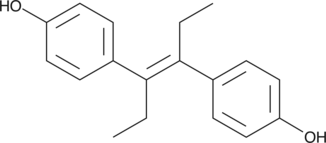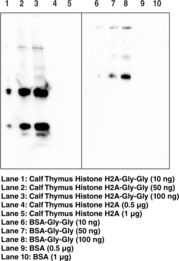Cayman
Showing 18151–18300 of 45550 results
-
Diethylstilbestrol (DES) is a synthetic estrogen receptor agonist that was prescribed to pregnant women in the late 1930s. It was banned in 1971 because of possible links to increased risk of breast cancer in mothers along with congenital abnormalities and increased risk of cancer in offspring.{12906} DES is structurally related to, and is as potent as, estradiol in most assays, with a longer half-life. It has a relative binding affinity to sex hormone binding globulin (SHBG) of 0.2 compared to estradiol which has a relative binding affinity of 100. A concentration of 20 µM DES, displaces 30 ± 13% of 3H-estradiol from SHBG in serum.{12906,12990}
Brand:CaymanSKU:10006876 - 1 gAvailable on backorder
Diethylstilbestrol (DES) is a synthetic estrogen receptor agonist that was prescribed to pregnant women in the late 1930s. It was banned in 1971 because of possible links to increased risk of breast cancer in mothers along with congenital abnormalities and increased risk of cancer in offspring.{12906} DES is structurally related to, and is as potent as, estradiol in most assays, with a longer half-life. It has a relative binding affinity to sex hormone binding globulin (SHBG) of 0.2 compared to estradiol which has a relative binding affinity of 100. A concentration of 20 µM DES, displaces 30 ± 13% of 3H-estradiol from SHBG in serum.{12906,12990}
Brand:CaymanSKU:10006876 - 10 gAvailable on backorder
Diethylstilbestrol (DES) is a synthetic estrogen receptor agonist that was prescribed to pregnant women in the late 1930s. It was banned in 1971 because of possible links to increased risk of breast cancer in mothers along with congenital abnormalities and increased risk of cancer in offspring.{12906} DES is structurally related to, and is as potent as, estradiol in most assays, with a longer half-life. It has a relative binding affinity to sex hormone binding globulin (SHBG) of 0.2 compared to estradiol which has a relative binding affinity of 100. A concentration of 20 µM DES, displaces 30 ± 13% of 3H-estradiol from SHBG in serum.{12906,12990}
Brand:CaymanSKU:10006876 - 25 gAvailable on backorder
Diethylstilbestrol (DES) is a synthetic estrogen receptor agonist that was prescribed to pregnant women in the late 1930s. It was banned in 1971 because of possible links to increased risk of breast cancer in mothers along with congenital abnormalities and increased risk of cancer in offspring.{12906} DES is structurally related to, and is as potent as, estradiol in most assays, with a longer half-life. It has a relative binding affinity to sex hormone binding globulin (SHBG) of 0.2 compared to estradiol which has a relative binding affinity of 100. A concentration of 20 µM DES, displaces 30 ± 13% of 3H-estradiol from SHBG in serum.{12906,12990}
Brand:CaymanSKU:10006876 - 5 gAvailable on backorder
Difenoconazole is a broad-spectrum triazole fungicide that inhibits ergosterol biosynthesis via inhibition of the cytochrome P450-dependent 14α-demethylation of lanosterol, which results in disruption of the fungal cell membrane and cell death.{30331,39666} It inhibits the growth of F. graminearum isolates in vitro (EC50s = 1.69-19.6 mg/L for mycelial growth).{39666} It also inhibits growth of A. sonali, F. fulva, B. cinerea, and R. solani (EC50s = 0.131, 0.069, 0.297, and 0.252 mg/L, respectively).{39667} Difenoconazole reduces germtube growth of A. caricae, the mold responsible for black spot in papaya plants (EC50 = 2 ppm).{39668} It exhibits acute aquatic toxicity, reducing growth of S. obliquus algae (EC50 = 1.338 μg/ml) and decreasing survival of D. magna (LD50 = 0.298 μg/ml).{39667} Difenoconazole is also lethal to zebrafish (D. rerio) embryos, larvae, and adults (LC50s = 2.34, 1.17, and 1.45 mg/L, respectively).{39669} At sub-LC50 concentrations, difenoconazole induces pericardial and yolk sac edema in zebrafish embryos, body blackening and slowed heart rate in larvae, and decreased body weight and length in adults.
Brand:CaymanSKU:24053 - 100 mgAvailable on backorder
Difenoconazole is a broad-spectrum triazole fungicide that inhibits ergosterol biosynthesis via inhibition of the cytochrome P450-dependent 14α-demethylation of lanosterol, which results in disruption of the fungal cell membrane and cell death.{30331,39666} It inhibits the growth of F. graminearum isolates in vitro (EC50s = 1.69-19.6 mg/L for mycelial growth).{39666} It also inhibits growth of A. sonali, F. fulva, B. cinerea, and R. solani (EC50s = 0.131, 0.069, 0.297, and 0.252 mg/L, respectively).{39667} Difenoconazole reduces germtube growth of A. caricae, the mold responsible for black spot in papaya plants (EC50 = 2 ppm).{39668} It exhibits acute aquatic toxicity, reducing growth of S. obliquus algae (EC50 = 1.338 μg/ml) and decreasing survival of D. magna (LD50 = 0.298 μg/ml).{39667} Difenoconazole is also lethal to zebrafish (D. rerio) embryos, larvae, and adults (LC50s = 2.34, 1.17, and 1.45 mg/L, respectively).{39669} At sub-LC50 concentrations, difenoconazole induces pericardial and yolk sac edema in zebrafish embryos, body blackening and slowed heart rate in larvae, and decreased body weight and length in adults.
Brand:CaymanSKU:24053 - 50 mgAvailable on backorder
Diffractaic acid is a lichen metabolite that has been found in P. magellanica and has diverse biological activities.{36882,36883,36884,36885} It is cytotoxic to HCT116, HeLa, and MCF-7 cancer cells (IC50s = 42.2, 64.6, and 93.4 μM, respectively).{36882} Diffractaic acid inhibits growth of M. tuberculosis (MIC = 41.7 μM).{36883} In vivo, diffractaic acid (25-200 mg/kg) reduces neutrophil infiltration, lipid peroxidation, myeloperoxidase (MPx) activity, and the number of gastric lesions as well as reverses decreases in superoxide dismutase (SOD) and glutathione peroxidase (GPx) activities induced by indomethacin (Item No. 70270) in rat gastric mucosa.{36884} Diffractaic acid also has analgesic activity, reducing acetic acid-induced writhing and increasing the pressure pain threshold in mice.{36885}
Brand:CaymanSKU:24208 - 2.5 mgAvailable on backorder
Diffractaic acid is a lichen metabolite that has been found in P. magellanica and has diverse biological activities.{36882,36883,36884,36885} It is cytotoxic to HCT116, HeLa, and MCF-7 cancer cells (IC50s = 42.2, 64.6, and 93.4 μM, respectively).{36882} Diffractaic acid inhibits growth of M. tuberculosis (MIC = 41.7 μM).{36883} In vivo, diffractaic acid (25-200 mg/kg) reduces neutrophil infiltration, lipid peroxidation, myeloperoxidase (MPx) activity, and the number of gastric lesions as well as reverses decreases in superoxide dismutase (SOD) and glutathione peroxidase (GPx) activities induced by indomethacin (Item No. 70270) in rat gastric mucosa.{36884} Diffractaic acid also has analgesic activity, reducing acetic acid-induced writhing and increasing the pressure pain threshold in mice.{36885}
Brand:CaymanSKU:24208 - 500 µgAvailable on backorder
Diflapolin is a dual inhibitor of 5-lipoxygenase-activating protein (FLAP) and soluble epoxide hydrolase (sEH).{45247} It inhibits formation of the 5-lipoxygenase (5-LO) products leukotriene B4 (LTB4; Item No. 20110) and 5-HpETE (Item No. 44230) in isolated human monocytes and neutrophils (IC50s = 30 and 170 nM, respectively) and inhibits the epoxide hydrolase activity of sEH with an IC50 value of 20 nM in a cell-free assay. It is selective for FLAP and sEH over other arachidonic acid metabolism enzymes, including 5-LO, LTC4 synthase, mPGES-1, COX-1, or COX-2 in cell-free assays, as well as 12- and 15-LO in neutrophils. Diflapolin (1, 3, and 10 mg/kg) decreases inflammation in a mouse model of peritonitis induced by zymosan, reducing the production of LTB4 and LTC4 and inhibiting leukocyte recruitment.
Brand:CaymanSKU:28103 - 1 mgAvailable on backorder
Diflapolin is a dual inhibitor of 5-lipoxygenase-activating protein (FLAP) and soluble epoxide hydrolase (sEH).{45247} It inhibits formation of the 5-lipoxygenase (5-LO) products leukotriene B4 (LTB4; Item No. 20110) and 5-HpETE (Item No. 44230) in isolated human monocytes and neutrophils (IC50s = 30 and 170 nM, respectively) and inhibits the epoxide hydrolase activity of sEH with an IC50 value of 20 nM in a cell-free assay. It is selective for FLAP and sEH over other arachidonic acid metabolism enzymes, including 5-LO, LTC4 synthase, mPGES-1, COX-1, or COX-2 in cell-free assays, as well as 12- and 15-LO in neutrophils. Diflapolin (1, 3, and 10 mg/kg) decreases inflammation in a mouse model of peritonitis induced by zymosan, reducing the production of LTB4 and LTC4 and inhibiting leukocyte recruitment.
Brand:CaymanSKU:28103 - 10 mgAvailable on backorder
Diflapolin is a dual inhibitor of 5-lipoxygenase-activating protein (FLAP) and soluble epoxide hydrolase (sEH).{45247} It inhibits formation of the 5-lipoxygenase (5-LO) products leukotriene B4 (LTB4; Item No. 20110) and 5-HpETE (Item No. 44230) in isolated human monocytes and neutrophils (IC50s = 30 and 170 nM, respectively) and inhibits the epoxide hydrolase activity of sEH with an IC50 value of 20 nM in a cell-free assay. It is selective for FLAP and sEH over other arachidonic acid metabolism enzymes, including 5-LO, LTC4 synthase, mPGES-1, COX-1, or COX-2 in cell-free assays, as well as 12- and 15-LO in neutrophils. Diflapolin (1, 3, and 10 mg/kg) decreases inflammation in a mouse model of peritonitis induced by zymosan, reducing the production of LTB4 and LTC4 and inhibiting leukocyte recruitment.
Brand:CaymanSKU:28103 - 5 mgAvailable on backorder
Diflorasone is a corticosteroid with anti-inflammatory activity.{37262} It reduces production of the inflammatory cytokines Il-6, Il-4, and macrophage inflammatory protein-2 (Mip-2) and completely inhibits swelling in the ears of toluene-2,4-diisocyaniate-sensitized mice following topical administration of 20 µL of a 0.05% solution. Diflorasone inhibits RANTES and thymus and activation regulated chemokine (TARC) in a dinitrochlorobenzene-induced mouse model of allergic contact dermatitis.{37263} It also inhibits proliferation of human keratinocytes in vitro and reduces epidermal thickening in a mouse model of psoriasis induced by imiquimod (Item No. 14956).{37264}
Brand:CaymanSKU:23808 - 10 mgAvailable on backorder
Diflorasone is a corticosteroid with anti-inflammatory activity.{37262} It reduces production of the inflammatory cytokines Il-6, Il-4, and macrophage inflammatory protein-2 (Mip-2) and completely inhibits swelling in the ears of toluene-2,4-diisocyaniate-sensitized mice following topical administration of 20 µL of a 0.05% solution. Diflorasone inhibits RANTES and thymus and activation regulated chemokine (TARC) in a dinitrochlorobenzene-induced mouse model of allergic contact dermatitis.{37263} It also inhibits proliferation of human keratinocytes in vitro and reduces epidermal thickening in a mouse model of psoriasis induced by imiquimod (Item No. 14956).{37264}
Brand:CaymanSKU:23808 - 5 mgAvailable on backorder
Difloxacin is a fluoroquinolone antibiotic.{32013} It is active against isolates of anaerobic bacteria, including B. fragilis, as well as Fusobacterium and Actinomyces species with MIC values ranging from ≤0.125 to 8 µg/ml. It eliminates E. coli and B. fragilis infection in a rat intra-abdominal abscess model when administered at a dose of 40 mg/kg three times per day.{49102}
Brand:CaymanSKU:29000 - 1 mgAvailable on backorder
Difloxacin is a fluoroquinolone antibiotic.{32013} It is active against isolates of anaerobic bacteria, including B. fragilis, as well as Fusobacterium and Actinomyces species with MIC values ranging from ≤0.125 to 8 µg/ml. It eliminates E. coli and B. fragilis infection in a rat intra-abdominal abscess model when administered at a dose of 40 mg/kg three times per day.{49102}
Brand:CaymanSKU:29000 - 25 mgAvailable on backorder
Difloxacin is a fluoroquinolone antibiotic.{32013} It is active against isolates of anaerobic bacteria, including B. fragilis, as well as Fusobacterium and Actinomyces species with MIC values ranging from ≤0.125 to 8 µg/ml. It eliminates E. coli and B. fragilis infection in a rat intra-abdominal abscess model when administered at a dose of 40 mg/kg three times per day.{49102}
Brand:CaymanSKU:29000 - 5 mgAvailable on backorder
Difloxacin-d3 is intended for use as an internal standard for the quantification of difloxacin by GC- or LC-MS. Difloxacin is a fluoroquinolone antibiotic.{32013} It is active against isolates of anaerobic bacteria, including B. fragilis, as well as Fusobacterium and Actinomyces species with MIC values ranging from ≤0.125 to 8 µg/ml. It eliminates E. coli and B. fragilis infection in a rat intra-abdominal abscess model when administered at a dose of 40 mg/kg three times per day.{49102}
Brand:CaymanSKU:27617 - 1 mgAvailable on backorder
Difloxacin-d3 is intended for use as an internal standard for the quantification of difloxacin by GC- or LC-MS. Difloxacin is a fluoroquinolone antibiotic.{32013} It is active against isolates of anaerobic bacteria, including B. fragilis, as well as Fusobacterium and Actinomyces species with MIC values ranging from ≤0.125 to 8 µg/ml. It eliminates E. coli and B. fragilis infection in a rat intra-abdominal abscess model when administered at a dose of 40 mg/kg three times per day.{49102}
Brand:CaymanSKU:27617 - 5 mgAvailable on backorder
Diflubenzuron is a benzoylphenylurea insecticide that inhibits chitin synthesis in insects with an IC50 value of 0.611 nM for 14C-labeled N-acetyl-D-glucosamine incorporation in the cockroach.{36193,36191} Specifically, it inhibits chitin synthetase at the egg and larval stages, leading to an inability to exit the egg or exocuticle, respectively.{36191} Diflubenzuron is genotoxic and mutagenic in mice at doses of 0.3, 1, and 3 mg/kg.{36190} Formulations containing diflubenzuron are used primarily in agricultural applications but are also used to control insects in livestock production.
Brand:CaymanSKU:23095 - 100 mgAvailable on backorder
Diflubenzuron is a benzoylphenylurea insecticide that inhibits chitin synthesis in insects with an IC50 value of 0.611 nM for 14C-labeled N-acetyl-D-glucosamine incorporation in the cockroach.{36193,36191} Specifically, it inhibits chitin synthetase at the egg and larval stages, leading to an inability to exit the egg or exocuticle, respectively.{36191} Diflubenzuron is genotoxic and mutagenic in mice at doses of 0.3, 1, and 3 mg/kg.{36190} Formulations containing diflubenzuron are used primarily in agricultural applications but are also used to control insects in livestock production.
Brand:CaymanSKU:23095 - 50 mgAvailable on backorder
Difludiazapam (Item No. 23507) is an analytical reference standard categorized as a benzodiazepine.{42550} This product is intended for research and forensic applications.
Brand:CaymanSKU:23507 - 1 mgAvailable on backorder
Difludiazapam (Item No. 23507) is an analytical reference standard categorized as a benzodiazepine.{42550} This product is intended for research and forensic applications.
Brand:CaymanSKU:23507 - 5 mgAvailable on backorder
Diflunisal is a non-steroidal anti-inflammatory drug (NSAID) that inhibits both COX-1 (IC50 = 113 µM) and COX-2 (IC50s = 8.2 and 134 µM for human whole blood assay and human-modified whole blood assays, respectively).{8427} Peak plasma levels are achieved within two hours, with little metabolism before excretion in the urine.{31037} The terminal plasma half-life is approximately eight hours.{31037}
Brand:CaymanSKU:-Available on backorder
Diflunisal is a non-steroidal anti-inflammatory drug (NSAID) that inhibits both COX-1 (IC50 = 113 µM) and COX-2 (IC50s = 8.2 and 134 µM for human whole blood assay and human-modified whole blood assays, respectively).{8427} Peak plasma levels are achieved within two hours, with little metabolism before excretion in the urine.{31037} The terminal plasma half-life is approximately eight hours.{31037}
Brand:CaymanSKU:-Available on backorder
Diflunisal is a non-steroidal anti-inflammatory drug (NSAID) that inhibits both COX-1 (IC50 = 113 µM) and COX-2 (IC50s = 8.2 and 134 µM for human whole blood assay and human-modified whole blood assays, respectively).{8427} Peak plasma levels are achieved within two hours, with little metabolism before excretion in the urine.{31037} The terminal plasma half-life is approximately eight hours.{31037}
Brand:CaymanSKU:-Available on backorder
Diflunisal is a non-steroidal anti-inflammatory drug (NSAID) that inhibits both COX-1 (IC50 = 113 µM) and COX-2 (IC50s = 8.2 and 134 µM for human whole blood assay and human-modified whole blood assays, respectively).{8427} Peak plasma levels are achieved within two hours, with little metabolism before excretion in the urine.{31037} The terminal plasma half-life is approximately eight hours.{31037}
Brand:CaymanSKU:-Available on backorder
Difluorinated H2S probe 1 is a fluorescent probe for hydrogen sulfide (H2S).{50798} It selectively fluoresces in the presence of H2S over Zn2+, Fe3+, S2O32-, ClO-, SO32-, H2O2, NO2-, cysteine (Cys), homocysteine (Hcy), and glutathione (GSH) when used at a concentration of 1 µM. Difluorinated H2S probe 1 displays excitation/emission maxima of 365/450 nm, respectively.
Brand:CaymanSKU:29835 - 1 mgAvailable on backorder
Difluorinated H2S probe 1 is a fluorescent probe for hydrogen sulfide (H2S).{50798} It selectively fluoresces in the presence of H2S over Zn2+, Fe3+, S2O32-, ClO-, SO32-, H2O2, NO2-, cysteine (Cys), homocysteine (Hcy), and glutathione (GSH) when used at a concentration of 1 µM. Difluorinated H2S probe 1 displays excitation/emission maxima of 365/450 nm, respectively.
Brand:CaymanSKU:29835 - 250 µgAvailable on backorder
Difluorinated H2S probe 1 is a fluorescent probe for hydrogen sulfide (H2S).{50798} It selectively fluoresces in the presence of H2S over Zn2+, Fe3+, S2O32-, ClO-, SO32-, H2O2, NO2-, cysteine (Cys), homocysteine (Hcy), and glutathione (GSH) when used at a concentration of 1 µM. Difluorinated H2S probe 1 displays excitation/emission maxima of 365/450 nm, respectively.
Brand:CaymanSKU:29835 - 500 µgAvailable on backorder
Difluprednate is a synthetic glucocorticoid that potently activates the glucocorticoid receptor (Ki = 78 pM).{41345} In vivo, ocular administration of difluprednate (0.05% w/v) increases intraocular pressure in sheep.{41346} Formulations containing difluprednate have been used to treat diabetic macular edema and inflammation following cataract surgery.
Brand:CaymanSKU:23776 - 10 mgAvailable on backorder
Difluprednate is a synthetic glucocorticoid that potently activates the glucocorticoid receptor (Ki = 78 pM).{41345} In vivo, ocular administration of difluprednate (0.05% w/v) increases intraocular pressure in sheep.{41346} Formulations containing difluprednate have been used to treat diabetic macular edema and inflammation following cataract surgery.
Brand:CaymanSKU:23776 - 25 mgAvailable on backorder
Difluprednate is a synthetic glucocorticoid that potently activates the glucocorticoid receptor (Ki = 78 pM).{41345} In vivo, ocular administration of difluprednate (0.05% w/v) increases intraocular pressure in sheep.{41346} Formulations containing difluprednate have been used to treat diabetic macular edema and inflammation following cataract surgery.
Brand:CaymanSKU:23776 - 50 mgAvailable on backorder
Digalactosyldiacylglyceride mixture is a mixture of digalactosyldiacylglyceride molecular species containing C18:0 and C16:0 acyl chains at approximately a 3:1 ratio. [Matreya, LLC. Catalog No. 1059]
Brand:CaymanSKU:27373 - 1 mgAvailable on backorder
Digalactosyldiacylglyceride mixture is a mixture of digalactosyldiacylglyceride molecular species containing C18:0 and C16:0 acyl chains at approximately a 3:1 ratio. [Matreya, LLC. Catalog No. 1059]
Brand:CaymanSKU:27373 - 5 mgAvailable on backorder
Digallic acid is a natural polyphenolic that can be produced by hydrolysis of gallotannins. Like other polyphenolic compounds, digallic acid has antioxidant activity that can be cytoprotective.{33306} Digallic acid inhibits reverse transcriptases from human immunodeficiency virus (Ki = 0.58 µM) and murine leukemia virus.{33307} It also inhibits calcium-activated chloride channels, blocking the initial agonist-stimulated chloride current.{29772}
Brand:CaymanSKU:21224 -Out of stock
Digitonin is a glycoside obtained from D. purpurea that is used as a non-ionic detergent to solubilize membrane-bound proteins, to precipitate cholesterol, and to permeabilize cell membranes.{24076,24077,24078}
Brand:CaymanSKU:-Digitonin is a glycoside obtained from D. purpurea that is used as a non-ionic detergent to solubilize membrane-bound proteins, to precipitate cholesterol, and to permeabilize cell membranes.{24076,24077,24078}
Brand:CaymanSKU:-Digitonin is a glycoside obtained from D. purpurea that is used as a non-ionic detergent to solubilize membrane-bound proteins, to precipitate cholesterol, and to permeabilize cell membranes.{24076,24077,24078}
Brand:CaymanSKU:-Digitonin is a glycoside obtained from D. purpurea that is used as a non-ionic detergent to solubilize membrane-bound proteins, to precipitate cholesterol, and to permeabilize cell membranes.{24076,24077,24078}
Brand:CaymanSKU:-Digitoxigenin is a cardenolide and aglycone constituent of digitoxin, an extract from the foxglove plant, D. purpurea. It elicits cardiac contraction and cardiotonic effects by inhibiting the Na+/K+ ATPase via binding at the digitalis receptor site with nanomolar potency.{23988,29469} Digitoxigenin is highly cytotoxic, inhibiting Na+/K+ ATPase-dependent protein synthesis, and has been examined for use as an antitumor compound.{29470}
Brand:CaymanSKU:-Available on backorder
Digitoxigenin is a cardenolide and aglycone constituent of digitoxin, an extract from the foxglove plant, D. purpurea. It elicits cardiac contraction and cardiotonic effects by inhibiting the Na+/K+ ATPase via binding at the digitalis receptor site with nanomolar potency.{23988,29469} Digitoxigenin is highly cytotoxic, inhibiting Na+/K+ ATPase-dependent protein synthesis, and has been examined for use as an antitumor compound.{29470}
Brand:CaymanSKU:-Available on backorder
Digitoxigenin is a cardenolide and aglycone constituent of digitoxin, an extract from the foxglove plant, D. purpurea. It elicits cardiac contraction and cardiotonic effects by inhibiting the Na+/K+ ATPase via binding at the digitalis receptor site with nanomolar potency.{23988,29469} Digitoxigenin is highly cytotoxic, inhibiting Na+/K+ ATPase-dependent protein synthesis, and has been examined for use as an antitumor compound.{29470}
Brand:CaymanSKU:-Available on backorder
Digitoxigenin is a cardenolide and aglycone constituent of digitoxin, an extract from the foxglove plant, D. purpurea. It elicits cardiac contraction and cardiotonic effects by inhibiting the Na+/K+ ATPase via binding at the digitalis receptor site with nanomolar potency.{23988,29469} Digitoxigenin is highly cytotoxic, inhibiting Na+/K+ ATPase-dependent protein synthesis, and has been examined for use as an antitumor compound.{29470}
Brand:CaymanSKU:-Available on backorder
Digitoxin is a cardiac glycoside that has been found in Digitalis and has diverse biological activities.{29469,52442,52443,52444,52445} It inhibits human recombinant α1β1, α2β2, and α3β1 subunit-containing Na+/K+-ATPases with Ki values of 250, 63, and 136 nM, respectively.{29469} Digitoxin inhibits the human-ether-a-go-go (hERG) potassium channel, also known as Kv11.1, in HEK293 cells expressing hERG (IC50 = 11.1 nM).{52442} It enhances developed tension and contractile force in electrically stimulated isolated guinea pig left atrial muscle when used at concentrations of 0.2 and 0.4 µM, respectively.{52443} Dietary administration of digitoxin (~1 mg/kg per day) attenuates congestive heart failure and reduces myocardial hypertrophy in a rat model of myocardial infarction induced by coronary artery ligation.{52444} Digitoxin is also cytotoxic to a panel of 10 human cancer cell lines, including myeloma, lymphoma, and leukemia cancer cells, with IC50 values ranging from 12 to 76 nM.{52445} Formulations containing digitoxin have previously been used in the treatment of congestive heart failure and cardiac arrhythmias.
Brand:CaymanSKU:27825 - 1 gAvailable on backorder
Digitoxin is a cardiac glycoside that has been found in Digitalis and has diverse biological activities.{29469,52442,52443,52444,52445} It inhibits human recombinant α1β1, α2β2, and α3β1 subunit-containing Na+/K+-ATPases with Ki values of 250, 63, and 136 nM, respectively.{29469} Digitoxin inhibits the human-ether-a-go-go (hERG) potassium channel, also known as Kv11.1, in HEK293 cells expressing hERG (IC50 = 11.1 nM).{52442} It enhances developed tension and contractile force in electrically stimulated isolated guinea pig left atrial muscle when used at concentrations of 0.2 and 0.4 µM, respectively.{52443} Dietary administration of digitoxin (~1 mg/kg per day) attenuates congestive heart failure and reduces myocardial hypertrophy in a rat model of myocardial infarction induced by coronary artery ligation.{52444} Digitoxin is also cytotoxic to a panel of 10 human cancer cell lines, including myeloma, lymphoma, and leukemia cancer cells, with IC50 values ranging from 12 to 76 nM.{52445} Formulations containing digitoxin have previously been used in the treatment of congestive heart failure and cardiac arrhythmias.
Brand:CaymanSKU:27825 - 100 mgAvailable on backorder
Digitoxin is a cardiac glycoside that has been found in Digitalis and has diverse biological activities.{29469,52442,52443,52444,52445} It inhibits human recombinant α1β1, α2β2, and α3β1 subunit-containing Na+/K+-ATPases with Ki values of 250, 63, and 136 nM, respectively.{29469} Digitoxin inhibits the human-ether-a-go-go (hERG) potassium channel, also known as Kv11.1, in HEK293 cells expressing hERG (IC50 = 11.1 nM).{52442} It enhances developed tension and contractile force in electrically stimulated isolated guinea pig left atrial muscle when used at concentrations of 0.2 and 0.4 µM, respectively.{52443} Dietary administration of digitoxin (~1 mg/kg per day) attenuates congestive heart failure and reduces myocardial hypertrophy in a rat model of myocardial infarction induced by coronary artery ligation.{52444} Digitoxin is also cytotoxic to a panel of 10 human cancer cell lines, including myeloma, lymphoma, and leukemia cancer cells, with IC50 values ranging from 12 to 76 nM.{52445} Formulations containing digitoxin have previously been used in the treatment of congestive heart failure and cardiac arrhythmias.
Brand:CaymanSKU:27825 - 250 mgAvailable on backorder
Digitoxin is a cardiac glycoside that has been found in Digitalis and has diverse biological activities.{29469,52442,52443,52444,52445} It inhibits human recombinant α1β1, α2β2, and α3β1 subunit-containing Na+/K+-ATPases with Ki values of 250, 63, and 136 nM, respectively.{29469} Digitoxin inhibits the human-ether-a-go-go (hERG) potassium channel, also known as Kv11.1, in HEK293 cells expressing hERG (IC50 = 11.1 nM).{52442} It enhances developed tension and contractile force in electrically stimulated isolated guinea pig left atrial muscle when used at concentrations of 0.2 and 0.4 µM, respectively.{52443} Dietary administration of digitoxin (~1 mg/kg per day) attenuates congestive heart failure and reduces myocardial hypertrophy in a rat model of myocardial infarction induced by coronary artery ligation.{52444} Digitoxin is also cytotoxic to a panel of 10 human cancer cell lines, including myeloma, lymphoma, and leukemia cancer cells, with IC50 values ranging from 12 to 76 nM.{52445} Formulations containing digitoxin have previously been used in the treatment of congestive heart failure and cardiac arrhythmias.
Brand:CaymanSKU:27825 - 500 mgAvailable on backorder
Immunogen: Diglycine-modified histone peptide • Host: Mouse • Species Reactivity: Species independent • Cross Reactivity: (+) Diglycyl-modified lysine, (-) Unmodified lysine • Applications: IP and WB
Brand:CaymanSKU:21096- 100 µgAvailable on backorder
Immunogen: Diglycine-modified histone peptide • Host: Mouse • Species Reactivity: Species independent • Cross Reactivity: (+) Diglycyl-modified lysine, (-) Unmodified lysine • Applications: IP and WB
Brand:CaymanSKU:21096- 100 µgDiglycyl-lysine is a ubiquitin remnant-containing peptide.{53413,32800} Diglycyl-lysine is formed during protein digestion with trypsin, which cleaves the arginine residue of ubiquitin, leaving diglycyl conjugated to lysine in protein digests.{32800} It has been used as a marker of prior ubiquitin conjugation in trypsin protein digests.{53413} Cayman’s Diglycyl-Lysine Monoclonal Antibody (Clone GX41) can be used for Western blot, and immunoprecipitation applications.
Brand:CaymanSKU:21096 - 100 µgAvailable on backorder
Digoxigenin monodigitoxoside is a Na+/K+-ATPase inhibitor and cardiac glycoside metabolite of digoxin (Item No. 22266).{35125} It has a binding affinity of 0.829 and an inhibitory potency of 1.07 relative to [3H]ouabain in a competitive binding assay using purified lamb Na+/K+-ATPase and for its ATPase activity, respectively.{35127} Digoxigenin monodigitoxoside is selective for the α3β1 isoform over α1β1 and α2β1 (Kds = 31.8, 65, and 35 nM, respectively).{29469} Digoxigenin monodigitoxoside produces a more potent inotropic response in perfused guinea pig hearts than digoxin with 60 and 46% increases in inotropy, respectively.{35125}
Brand:CaymanSKU:21699 -Out of stock
Digoxigenin monodigitoxoside is a Na+/K+-ATPase inhibitor and cardiac glycoside metabolite of digoxin (Item No. 22266).{35125} It has a binding affinity of 0.829 and an inhibitory potency of 1.07 relative to [3H]ouabain in a competitive binding assay using purified lamb Na+/K+-ATPase and for its ATPase activity, respectively.{35127} Digoxigenin monodigitoxoside is selective for the α3β1 isoform over α1β1 and α2β1 (Kds = 31.8, 65, and 35 nM, respectively).{29469} Digoxigenin monodigitoxoside produces a more potent inotropic response in perfused guinea pig hearts than digoxin with 60 and 46% increases in inotropy, respectively.{35125}
Brand:CaymanSKU:21699 -Out of stock
Digoxin is a cardiac glycoside and metabolite of digitoxin that binds to and inhibits the Na+/K+-ATPase in cardiac tissues in an ATP- and Mg2+-dependent manner.{38192} This inhibition results in loss of the transmembrane Na+ gradient, which decreases activity of the Na+/Ca2+ exchanger, increasing intracellular Ca2+ levels, inotropy, and cardiac force.{38193} It increases activity of mitochondrial ATPase and actomyosin ATPase in rat hearts, which is directly correlated with increased myofibrillar contractile strength.{38194} In vivo, digoxin also decreases right atrial pressure and increases cardiac output in a canine model of congestive heart failure produced by pulmonary artery constriction.{38195} Formulations containing digoxin have been used to treat atrial fibrillation.{38196}
Brand:CaymanSKU:22266 -Out of stock
Digoxin is a cardiac glycoside and metabolite of digitoxin that binds to and inhibits the Na+/K+-ATPase in cardiac tissues in an ATP- and Mg2+-dependent manner.{38192} This inhibition results in loss of the transmembrane Na+ gradient, which decreases activity of the Na+/Ca2+ exchanger, increasing intracellular Ca2+ levels, inotropy, and cardiac force.{38193} It increases activity of mitochondrial ATPase and actomyosin ATPase in rat hearts, which is directly correlated with increased myofibrillar contractile strength.{38194} In vivo, digoxin also decreases right atrial pressure and increases cardiac output in a canine model of congestive heart failure produced by pulmonary artery constriction.{38195} Formulations containing digoxin have been used to treat atrial fibrillation.{38196}
Brand:CaymanSKU:22266 -Out of stock
Digoxin is a cardiac glycoside and metabolite of digitoxin that binds to and inhibits the Na+/K+-ATPase in cardiac tissues in an ATP- and Mg2+-dependent manner.{38192} This inhibition results in loss of the transmembrane Na+ gradient, which decreases activity of the Na+/Ca2+ exchanger, increasing intracellular Ca2+ levels, inotropy, and cardiac force.{38193} It increases activity of mitochondrial ATPase and actomyosin ATPase in rat hearts, which is directly correlated with increased myofibrillar contractile strength.{38194} In vivo, digoxin also decreases right atrial pressure and increases cardiac output in a canine model of congestive heart failure produced by pulmonary artery constriction.{38195} Formulations containing digoxin have been used to treat atrial fibrillation.{38196}
Brand:CaymanSKU:22266 -Out of stock
Digoxin is a cardiac glycoside and metabolite of digitoxin that binds to and inhibits the Na+/K+-ATPase in cardiac tissues in an ATP- and Mg2+-dependent manner.{38192} This inhibition results in loss of the transmembrane Na+ gradient, which decreases activity of the Na+/Ca2+ exchanger, increasing intracellular Ca2+ levels, inotropy, and cardiac force.{38193} It increases activity of mitochondrial ATPase and actomyosin ATPase in rat hearts, which is directly correlated with increased myofibrillar contractile strength.{38194} In vivo, digoxin also decreases right atrial pressure and increases cardiac output in a canine model of congestive heart failure produced by pulmonary artery constriction.{38195} Formulations containing digoxin have been used to treat atrial fibrillation.{38196}
Brand:CaymanSKU:22266 -Out of stock
Digoxin-d3 is intended for use as an internal standard for the quantification of digoxin (Item No. 22266) by GC- or LC-MS. Digoxin is a cardiac glycoside and metabolite of digitoxin (Item No. 27825) that binds to and inhibits the Na+/K+-ATPase in cardiac tissues in an ATP- and Mg2+-dependent manner.{38192} This inhibition results in loss of the transmembrane Na+ gradient, which decreases activity of the Na+/Ca2+ exchanger, increasing intracellular Ca2+ levels, inotropy, and cardiac force.{38193} It increases activity of mitochondrial ATPase and actomyosin ATPase in rat hearts, which is directly correlated with increased myofibrillar contractile strength.{38194} In vivo, digoxin also decreases right atrial pressure and increases cardiac output in a canine model of congestive heart failure produced by pulmonary artery constriction.{38195} Formulations containing digoxin have been used to treat atrial fibrillation.{38196}
Brand:CaymanSKU:10010657 - 1 mgAvailable on backorder
Digoxin-d3 is intended for use as an internal standard for the quantification of digoxin (Item No. 22266) by GC- or LC-MS. Digoxin is a cardiac glycoside and metabolite of digitoxin (Item No. 27825) that binds to and inhibits the Na+/K+-ATPase in cardiac tissues in an ATP- and Mg2+-dependent manner.{38192} This inhibition results in loss of the transmembrane Na+ gradient, which decreases activity of the Na+/Ca2+ exchanger, increasing intracellular Ca2+ levels, inotropy, and cardiac force.{38193} It increases activity of mitochondrial ATPase and actomyosin ATPase in rat hearts, which is directly correlated with increased myofibrillar contractile strength.{38194} In vivo, digoxin also decreases right atrial pressure and increases cardiac output in a canine model of congestive heart failure produced by pulmonary artery constriction.{38195} Formulations containing digoxin have been used to treat atrial fibrillation.{38196}
Brand:CaymanSKU:10010657 - 5 mgAvailable on backorder
Digoxin-d3 is intended for use as an internal standard for the quantification of digoxin (Item No. 22266) by GC- or LC-MS. Digoxin is a cardiac glycoside and metabolite of digitoxin (Item No. 27825) that binds to and inhibits the Na+/K+-ATPase in cardiac tissues in an ATP- and Mg2+-dependent manner.{38192} This inhibition results in loss of the transmembrane Na+ gradient, which decreases activity of the Na+/Ca2+ exchanger, increasing intracellular Ca2+ levels, inotropy, and cardiac force.{38193} It increases activity of mitochondrial ATPase and actomyosin ATPase in rat hearts, which is directly correlated with increased myofibrillar contractile strength.{38194} In vivo, digoxin also decreases right atrial pressure and increases cardiac output in a canine model of congestive heart failure produced by pulmonary artery constriction.{38195} Formulations containing digoxin have been used to treat atrial fibrillation.{38196}
Brand:CaymanSKU:10010657 - 500 µgAvailable on backorder
Diheptadecanoin is a diacylglycerol that contains heptadecanoic acid (Item No. 19722) at two positions.
Brand:CaymanSKU:27002 - 100 mgAvailable on backorder
Diheptadecanoin is a diacylglycerol that contains heptadecanoic acid (Item No. 19722) at two positions.
Brand:CaymanSKU:27002 - 250 mgAvailable on backorder
Diheptadecanoin is a diacylglycerol that contains heptadecanoic acid (Item No. 19722) at two positions.
Brand:CaymanSKU:27002 - 50 mgAvailable on backorder
Diheptadecanoin is a diacylglycerol that contains heptadecanoic acid (Item No. 19722) at two positions.
Brand:CaymanSKU:27002 - 500 mgAvailable on backorder
Dihexa is an activator of the hepatocyte growth factor/c-Met (HGF/c-Met) system and an analog of the peptide angiotensin IV.{47455} It binds to HGF (Kd = 65 pM), inhibits HGF dimerization, and enhances activation of c-Met by HGF in HEK293 cells expressing c-Met. It increases the number of dendritic spines formed and increases the mean frequency of miniature excitatory post-synaptic currents (mEPSCs) in dissociated hippocampal neurons, effects that can be blocked by the HGF antagonist Hinge. Dihexa (2 mg/kg, i.p.) completely reverses scopolamine-induced learning deficits in the latency to find the platform and increases the time spent in the target quadrant in the Morris water maze in rats.{47456}
Brand:CaymanSKU:27484 - 10 mgAvailable on backorder
Dihexa is an activator of the hepatocyte growth factor/c-Met (HGF/c-Met) system and an analog of the peptide angiotensin IV.{47455} It binds to HGF (Kd = 65 pM), inhibits HGF dimerization, and enhances activation of c-Met by HGF in HEK293 cells expressing c-Met. It increases the number of dendritic spines formed and increases the mean frequency of miniature excitatory post-synaptic currents (mEPSCs) in dissociated hippocampal neurons, effects that can be blocked by the HGF antagonist Hinge. Dihexa (2 mg/kg, i.p.) completely reverses scopolamine-induced learning deficits in the latency to find the platform and increases the time spent in the target quadrant in the Morris water maze in rats.{47456}
Brand:CaymanSKU:27484 - 25 mgAvailable on backorder
Dihexa is an activator of the hepatocyte growth factor/c-Met (HGF/c-Met) system and an analog of the peptide angiotensin IV.{47455} It binds to HGF (Kd = 65 pM), inhibits HGF dimerization, and enhances activation of c-Met by HGF in HEK293 cells expressing c-Met. It increases the number of dendritic spines formed and increases the mean frequency of miniature excitatory post-synaptic currents (mEPSCs) in dissociated hippocampal neurons, effects that can be blocked by the HGF antagonist Hinge. Dihexa (2 mg/kg, i.p.) completely reverses scopolamine-induced learning deficits in the latency to find the platform and increases the time spent in the target quadrant in the Morris water maze in rats.{47456}
Brand:CaymanSKU:27484 - 5 mgAvailable on backorder
Dihexa is an activator of the hepatocyte growth factor/c-Met (HGF/c-Met) system and an analog of the peptide angiotensin IV.{47455} It binds to HGF (Kd = 65 pM), inhibits HGF dimerization, and enhances activation of c-Met by HGF in HEK293 cells expressing c-Met. It increases the number of dendritic spines formed and increases the mean frequency of miniature excitatory post-synaptic currents (mEPSCs) in dissociated hippocampal neurons, effects that can be blocked by the HGF antagonist Hinge. Dihexa (2 mg/kg, i.p.) completely reverses scopolamine-induced learning deficits in the latency to find the platform and increases the time spent in the target quadrant in the Morris water maze in rats.{47456}
Brand:CaymanSKU:27484 - 50 mgAvailable on backorder
Dihexadecyl phosphate is a negatively-charged synthetic phospholipid that has been used to impart a negative charge to neutral liposomes.{37728} It has also been used in the generation of micelles, liposomes, and other types of artificial membranes, including niosomes for drug delivery.{37729,37730} Formulations containing dihexadecyl phosphate have been used as emulsifying agents in cosmetics.
Brand:CaymanSKU:25727 - 1 gAvailable on backorder
Dihexadecyl phosphate is a negatively-charged synthetic phospholipid that has been used to impart a negative charge to neutral liposomes.{37728} It has also been used in the generation of micelles, liposomes, and other types of artificial membranes, including niosomes for drug delivery.{37729,37730} Formulations containing dihexadecyl phosphate have been used as emulsifying agents in cosmetics.
Brand:CaymanSKU:25727 - 10 gAvailable on backorder
Dihexadecyl phosphate is a negatively-charged synthetic phospholipid that has been used to impart a negative charge to neutral liposomes.{37728} It has also been used in the generation of micelles, liposomes, and other types of artificial membranes, including niosomes for drug delivery.{37729,37730} Formulations containing dihexadecyl phosphate have been used as emulsifying agents in cosmetics.
Brand:CaymanSKU:25727 - 25 gAvailable on backorder
Dihexadecyl phosphate is a negatively-charged synthetic phospholipid that has been used to impart a negative charge to neutral liposomes.{37728} It has also been used in the generation of micelles, liposomes, and other types of artificial membranes, including niosomes for drug delivery.{37729,37730} Formulations containing dihexadecyl phosphate have been used as emulsifying agents in cosmetics.
Brand:CaymanSKU:25727 - 5 gAvailable on backorder
Dihexanoin is a diacylglycerol that contains the saturated short-chain fatty acid hexanoic acid at two positions.
Brand:CaymanSKU:27293 - 100 mgAvailable on backorder
Dihexanoin is a diacylglycerol that contains the saturated short-chain fatty acid hexanoic acid at two positions.
Brand:CaymanSKU:27293 - 25 mgAvailable on backorder
Dihexanoin is a diacylglycerol that contains the saturated short-chain fatty acid hexanoic acid at two positions.
Brand:CaymanSKU:27293 - 250 mgAvailable on backorder
Dihexanoin is a diacylglycerol that contains the saturated short-chain fatty acid hexanoic acid at two positions.
Brand:CaymanSKU:27293 - 50 mgAvailable on backorder
Dihomo-γ-Linolenic Acid (DGLA, 20:3), an elongation product of γ-linolenic acid (18:3), is rapidly metabolized by fatty acid desaturases to produce arachidonic acid (20:4). DGLA is metabolized through the cyclooxygenase pathway to produce 1-series prostaglandins, including PGE1.{2244,10906} In mice, DGLA supplementation in the diet can reduce atopic dermatitis and atherosclerosis.{19739,19738}
Brand:CaymanSKU:90230 - 10 mgAvailable on backorder
Dihomo-γ-Linolenic Acid (DGLA, 20:3), an elongation product of γ-linolenic acid (18:3), is rapidly metabolized by fatty acid desaturases to produce arachidonic acid (20:4). DGLA is metabolized through the cyclooxygenase pathway to produce 1-series prostaglandins, including PGE1.{2244,10906} In mice, DGLA supplementation in the diet can reduce atopic dermatitis and atherosclerosis.{19739,19738}
Brand:CaymanSKU:90230 - 100 mgAvailable on backorder
Dihomo-γ-Linolenic Acid (DGLA, 20:3), an elongation product of γ-linolenic acid (18:3), is rapidly metabolized by fatty acid desaturases to produce arachidonic acid (20:4). DGLA is metabolized through the cyclooxygenase pathway to produce 1-series prostaglandins, including PGE1.{2244,10906} In mice, DGLA supplementation in the diet can reduce atopic dermatitis and atherosclerosis.{19739,19738}
Brand:CaymanSKU:90230 - 50 mgAvailable on backorder
Dihomo-γ-Linolenic Acid (DGLA, 20:3), an elongation product of γ-linolenic acid (18:3), is rapidly metabolized by fatty acid desaturases to produce arachidonic acid (20:4). DGLA is metabolized through the cyclooxygenase pathway to produce 1-series prostaglandins, including PGE1.{2244,10906} In mice, DGLA supplementation in the diet can reduce atopic dermatitis and atherosclerosis.{19739,19738}
Brand:CaymanSKU:90230 - 500 mgAvailable on backorder
Dihomo-γ-linolenic acid (DGLA) is a metabolite produced by chain elongation of the essential fatty acid γ-linolenic acid. Ethyl DGLA is an esterified version of the free acid which is less water soluble, but more amenable for the formulation of DGLA-containing diets and dietary supplements. DGLA has been advanced as a possible treatment for various inflammatory disorders.{2361,1398} Evening primrose oil is a DGLA-rich nutraceutical which has been advocated for such uses.
Brand:CaymanSKU:90236 - 10 mgAvailable on backorder
Dihomo-γ-linolenic acid (DGLA) is a metabolite produced by chain elongation of the essential fatty acid γ-linolenic acid. Ethyl DGLA is an esterified version of the free acid which is less water soluble, but more amenable for the formulation of DGLA-containing diets and dietary supplements. DGLA has been advanced as a possible treatment for various inflammatory disorders.{2361,1398} Evening primrose oil is a DGLA-rich nutraceutical which has been advocated for such uses.
Brand:CaymanSKU:90236 - 100 mgAvailable on backorder


















![A Na+/K+-ATPase inhibitor; cardiac glycoside metabolite of digoxin; has a binding affinity of 0.829 relative to [3H]ouabain; has an inhibitory potency of 1.07 relative to [3H]ouabain for its ATPase activity; selective for the α3β1 isoform over α1β1 and α2β1 (Kds = 31.8](https://interpriseusa.com/wp-content/uploads/2021/06/21699.png)







